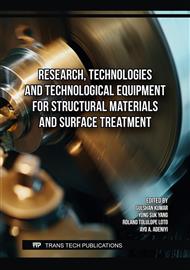[1]
J. Mortimer, Jaguar 'Roadmap' rethinks self-piercing technology, Ind. Robot: Int. J. 32 (2005) 209-213.
DOI: 10.1108/01439910510593875
Google Scholar
[2]
M. Newishy, et al., Friction Stir Welding of Dissimilar Al 6061-T6 to AISI 316 Stainless Steel: Microstructure and Mechanical Properties, Mater. 16 (2023) 4085.
DOI: 10.3390/ma16114085
Google Scholar
[3]
M.H. Fahmy, et al., Friction stir spot welding of AA2024-T3 with modified refill technique, Key Eng. Mater. 835 (2020) 274-287.
DOI: 10.4028/www.scientific.net/kem.835.274
Google Scholar
[4]
R. Hancock, Friction welding of aluminum cuts energy costs by 99%, Weld. J. 83 (2004)40-43.
Google Scholar
[5]
T. Shibayanagi, et al., Friction stir spot welding of pure aluminum sheet in view of high temperature deformation, Trans. JWRI 40 (2011) 1-5.
Google Scholar
[6]
T. Pan, Friction Stir Spot Welding (FSSW) - A Literature Review, SAE Technical Paper 2007-01-1702, Res. Adv. Eng., Ford Motor Company, 2007, 1-12.
DOI: 10.4271/2007-01-1702
Google Scholar
[7]
Y. Xu, et al., Precipitation behavior of intermetallic compounds and their effect on mechanical properties of thick plate friction stir welded Al/Mg joint, J. Manuf. Process. 64 (2021) 1059-1069.
DOI: 10.1016/j.jmapro.2020.12.068
Google Scholar
[8]
M. Ragab, et al., Numerical and experimental study of underwater friction stir welding of 1Cr11Ni2W2MoV heat-resistant stainless steel, J. Mater. Res. Technol. 29 (2024) 130-148.
DOI: 10.1016/j.jmrt.2024.01.100
Google Scholar
[9]
V. Balasubramanian, Relationship between base metal properties and friction stir welding process parameters, Mater. Sci. Eng. 480 (2007) 397-403.
DOI: 10.1016/j.msea.2007.07.048
Google Scholar
[10]
R. Karthikeyan, V. Balasubramanian, Predictions of the optimized friction stir spot welding process parameters for joining AA2024 aluminum alloy using RSM, Int. J. Adv. Manuf. Technol. 51 (2010) 173-183.
DOI: 10.1007/s00170-010-2618-2
Google Scholar
[11]
M. El-Shennawy, H.A. Abdel-Aleem, M.M. Ghanem, A.M. Sehsah. Effect of welding parameters on microstructure and mechanical properties of dissimilar AISI 304/ductile cast iron fusion welded joints. Sci Rep. 2024;14:19827.
DOI: 10.1038/s41598-024-70050-0
Google Scholar
[12]
J. You, et al., Improving the microstructure and mechanical properties of Al-Cu dissimilar joints by ultrasonic dynamic-stationary shoulder friction stir welding, J. Mater. Process. Technol. 311 (2023) 117812.
DOI: 10.1016/j.jmatprotec.2022.117812
Google Scholar
[13]
O. Mypati, et al., An investigation of mechanical and electrical properties of friction stir welded Al and Cu busbar for battery pack applications, Mater. Chem. Phys. 287 (2022) 126373.
DOI: 10.1016/j.matchemphys.2022.126373
Google Scholar
[14]
C. Connolly, Friction spot joining in aluminum car bodies, Ind. Robot: Int. J. 34 (2007) 17-20.
DOI: 10.1108/01439910710718397
Google Scholar
[15]
R. Khajeh, et al., Strength-ductility synergic enhancement in friction stir welded AA2024 alloy and copper joints: Unravelling the role of Zn interlayer's thickness, J. Mater. Res. Technol. 16 (2022) 251-262.
DOI: 10.1016/j.jmrt.2021.11.133
Google Scholar
[16]
H. Abdel-Aleem, et al., Evaluation of ultrasonic dissimilar welds by ultrasonic testing immersion method C-scope mode, Acad. J. Manuf. Eng. 15 (2017).
Google Scholar
[17]
S.A. Khodir, et al., Effect of intermetallic compound phases on the mechanical properties of the dissimilar Al/Cu friction stir welded joints, J. Mater. Eng. Perform. 25 (2016) 4637-4648.
DOI: 10.1007/s11665-016-2314-y
Google Scholar
[18]
W.B. Lee, S.B. Jung, Void free friction stir weld zone of the dissimilar 6061 aluminum and copper joint by shifting the tool insertion location, Mater. Res. Innov. 8 (2004) 93-96.
DOI: 10.1080/14328917.2004.11784837
Google Scholar
[19]
M. Morsy, H. Abdel-Aleem, E. El-KASHIF, Dissimilar Friction Stir Spot Welding of Aluminum, Steel, and Brass Alloys, J. Eng. Appl. Sci. 57 (2010) 149-165.
Google Scholar
[20]
H. Abdel-Aleem, et al., Evaluation by ultrasonic testing and TEM observation of bond interface for ultrasonic bonds of 5052/SUS304 and 5052/SPCC, Q. J. Jpn. Weld. Soc. 23 (2005) 194-202.
DOI: 10.2207/qjjws.23.194
Google Scholar
[21]
H. Abdel-Aleem, et al., Joining of A1050/A5052 and A1050/Cu by Ultrasonic Bonding and their Materials Evaluation, Q. J. Jpn. Weld. Soc. 21 (2003) 493-500.
DOI: 10.2207/qjjws.21.493
Google Scholar
[22]
A. Bezazi, S. Gareth Pierce, K. Worden, Fatigue life prediction of sandwich composite materials under flexural tests using a Bayesian trained artificial neural network, Int. J. Fatigue 29 (2007) 738-747.
DOI: 10.1016/j.ijfatigue.2006.06.013
Google Scholar
[23]
V. Moosabeiki Dehabadi, S. Ghorbanpour, G. Azimi, Application of artificial neural network to predict Vickers microhardness of AA6061 friction stir welded sheets, J. Cent. South Univ. 23 (2016) 2146-2155.
DOI: 10.1007/s11771-016-3271-1
Google Scholar
[24]
H. Atharifar, Optimum parameters design for friction stir spot welding using a genetically optimized neural network system, Dep. Ind. Technol., Millersville Univ. Pennsylvania, Millersville, PA 17551, USA, 2009, 1-10.
DOI: 10.1243/09544054jem1467
Google Scholar
[25]
J. Kiusalaas, Numerical methods in engineering with matlab, Cambridge University Press, New York, USA, 2009, 1-435.
Google Scholar


